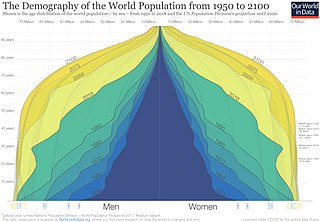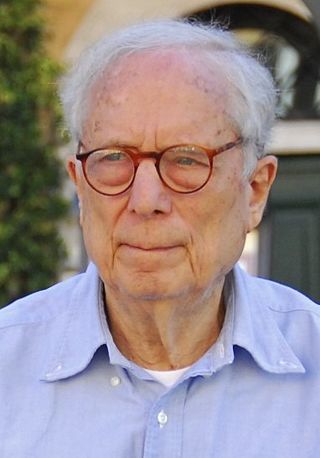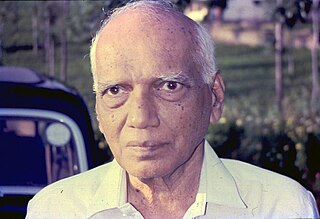
Demography is the statistical study of populations, especially human beings.

Robert Charles Venturi Jr. was an American architect, founding principal of the firm Venturi, Scott Brown and Associates, and one of the major architectural figures of the twentieth century.

Joseph Samuel Nye Jr. is an American political scientist. He and Robert Keohane co-founded the international relations theory of neoliberalism, which they developed in their 1977 book Power and Interdependence. Together with Keohane, he developed the concepts of asymmetrical and complex interdependence. They also explored transnational relations and world politics in an edited volume in the 1970s. More recently, he pioneered the theory of soft power and explained the distinction between it and hard power. His notion of "smart power" became popular with the use of this phrase by members of the Clinton Administration and the Obama Administration.

Preston Ercelle Cloud, Jr. was an American earth scientist, biogeologist, cosmologist, and paleontologist. He served in the United States Navy, and led several field explorations of the U.S. Geological Survey. In academia, he was a member of the faculty of Harvard University, University of Minnesota, University of California, Los Angeles, and lastly University of California, Santa Barbara. He was best known for his work on the geologic time scale and the origin of life on Earth, and as a pioneering ecologist and environmentalist. His works on the significance of Cambrian fossils in the 1940s led to the development of the concept "Cambrian explosion," for which he coined the phrase "eruptive evolution."
Kingsley Davis was an internationally recognized American sociologist and demographer. He was identified by the American Philosophical Society as one of the most outstanding social scientists of the twentieth century, and was a Hoover Institution senior research fellow.
Ansley Johnson Coale, was one of America's foremost demographers. A native to Baltimore, Maryland, he earned his Bachelor of Arts in 1939, his Master of Arts in 1941, and his Ph.D. in 1947, all at Princeton University. A long-term director of the Office of Population Research at Princeton, Coale was especially influential for his work on the demographic transition and for his leadership of the European Fertility Project.
Frank Wallace Notestein was an American demographer who contributed significantly to the development of the science. He was the founding director of the Office of Population Research at Princeton University, and later president of the Population Council. He was the first director-consultant of the Population Division of the United Nations from 1947–1948.
P. N. Mari Bhat (1951–2007), distinguished Indian demographer, was a student of Samuel H. Preston at the University of Pennsylvania from where he received his Ph.D. in 1987. At the time of his death he was the director of the International Institute for Population Sciences (IIPS) in Mumbai, which he formerly attended as a student.
James Benjamin Martel is a physician, surgeon and scientist. He is former Chair of Surgery, Mercy San Juan Medical Center, former Chief of Ophthalmology, Otolaryngology (ENT), and Plastic Surgery, Sutter Roseville Medical Center. He is the former Director of Ophthalmology, Sutter General and Memorial Hospitals and Assistant Professor of Ophthalmology and Radiology, Johns Hopkins Medical School and Wilmer Ophthalmological Institute. He is currently Clinical Professor of Ophthalmology and Associate Dean of Graduate Medical Education in California Northstate University College of Medicine.
Ronald Murray Berndt was an Australian social anthropologist who, in 1963, became the inaugural professor of anthropology at the University of Western Australia.

John Paul Holdren is an American scientist who served as the senior advisor to President Barack Obama on science and technology issues through his roles as Assistant to the President for Science and Technology, Director of the White House Office of Science and Technology Policy, and Co-Chair of the President's Council of Advisors on Science and Technology (PCAST).

Margaret Dauler Wilson was an American philosopher and a professor of philosophy at Princeton University between 1970 and 1998.

G. Marius Clore MAE, FRSC, FRS is a British-born, Anglo-American molecular biophysicist and structural biologist. He was born in London, U.K. and is a dual U.S./U.K. Citizen. He is a Member of the National Academy of Sciences, a Fellow of the Royal Society, a NIH Distinguished Investigator, and the Chief of the Molecular and Structural Biophysics Section in the Laboratory of Chemical Physics of the National Institute of Diabetes and Digestive and Kidney Diseases at the U.S. National Institutes of Health. He is known for his foundational work in three-dimensional protein and nucleic acid structure determination by biomolecular NMR spectroscopy, for advancing experimental approaches to the study of large macromolecules and their complexes by NMR, and for developing NMR-based methods to study rare conformational states in protein-nucleic acid and protein-protein recognition. Clore's discovery of previously undetectable, functionally significant, rare transient states of macromolecules has yielded fundamental new insights into the mechanisms of important biological processes, and in particular the significance of weak interactions and the mechanisms whereby the opposing constraints of speed and specificity are optimized. Further, Clore's work opens up a new era of pharmacology and drug design as it is now possible to target structures and conformations that have been heretofore unseen.

Natteri Veeraraghavan (1913-2004) was an Indian physician, microbiologist and medical researcher, known for his contributions to the understanding of diseases like rabies, tuberculosis and leprosy. He was a former director of the Pasteur Institute of India, Coonoor and the chairman of the World Health Organization International Reference Center on Rabies. He was honoured by the Government of India in 1967, with the award of Padma Shri, the fourth highest Indian civilian award for his contributions to the society.
John P. M. Bongaarts is a Dutch-American demographer. He serves as Vice-President and Distinguished Scholar at the Population Council, where he has worked since the 1970s. Bongaart has performed research in a diverse set of topics, such as population growth and aging, mortality, population-environment links and demography related to the epidemiology of HIV/AIDS. His most recognized work lies in the field of fertility, and has been a topic of interest throughout his career.
Prafullachandra Vishnu Sane is an Indian molecular biologist and plant physiologist, known for his pioneering studies on photosynthesis. He is a former director of National Botanical Research Institute and an elected fellow of the Indian Academy of Sciences, Indian National Science Academy, National Academy of Sciences, India, National Academy of Agricultural Sciences and the Maharashtra Academy of Sciences. The Council of Scientific and Industrial Research, the apex agency of the Government of India for scientific research, awarded him the Shanti Swarup Bhatnagar Prize for Science and Technology, one of the highest Indian science awards, in 1981, for his contributions to biological sciences.
William Brass was a Scottish demographer. He developed indirect methods for estimating mortality and fertility in populations with inaccurate or incomplete data, often dubbed "Brass methods" after him.
James Joseph Fox is an American anthropologist and historian of Indonesia.

Atish Dabholkar is an Indian theoretical physicist. He is currently the Director of the Abdus Salam International Centre for Theoretical Physics (ICTP) with the rank of Assistant Director-General, UNESCO. Prior to that, he was head of ICTP's High Energy, Cosmology and Astroparticle Physics section, and also Directeur de Recherche at the Centre National de la Recherche Scientifique (CNRS) at Sorbonne University in the "Laboratoire de Physique Théorique et Hautes Énergies" (LPTHE).
Mark Westoby is an Australian evolutionary ecologist, emeritus professor at Macquarie University, and a specialist in trait ecology.








